Contents
Market Overview
Macro Review
The IMF expects the growth differential between EM and DM to noticeably improve in 2023. This is set to be driven by EM as DM softens. That’s a constructive picture for EM credit investors. The second IMF theme of the week was China’s role and involvement of private creditors. Needless to say, it is increasingly unlikely that China will follow in the footsteps of the Paris Club. A third theme is around the complexity of deteriorating geopolitical relations with the U.S. and China. The more immediate focus was on whether the U.S. enters a recession or not. The Fed’s FOMC minutes now project a mild recession later this year, to the contrary of some Fedspeakers. A slowing in U.S. inflation, followed by PPI surprising to the downside and recording its slowest rise since 2020 was one signal. Then weekly initial jobless claims came in above expectations for a third week running. However, U.S. unemployment remains around its lowest in decades, but a high level of vacancies and even the financial market turmoil in the aftermath of SVB and Credit Suisse has been shrugged off. For EM investors, attention is shifting to the Turkish elections as we enter the final four weeks of the campaign. The basic question is whether CHP’s Kilicdaroglu can secure more than 50% of the vote to prevent a second-round run-off which is being complicated by Erdogan’s AKP forging closer alliances with MHP. However, the debate of the week was around whether Ince’s Homeland Party could force a second-round run-off. So far, the National Alliance / Table of Six appear united behind Kilicdaroglu, yet the direction from the ATA Alliance is more uncertain. In any event, we have seen Turkish local bonds normalize, with yields spiking from 8-9% to over 15% over the past week. The volatility is concerning but we are still yet to see any contagion spread across to other Turkish asset classes.
EM Credit Update
Emerging market sovereign credit (cash bonds) ended the week up 0.1% with spreads 1bp tighter. Sovereign outperformers were Pakistan, Argentina and Mongolia, while Sri Lanka, Tunisia and Bolivia underperformed. The more frenetic moves were in EM local currency products, which gained 1.0% as the DXY moved back to levels not seen since last April.
The Week Ahead
China’s GDP is the main fixture of next week, along with U.S. earnings. The PBoC are also unlikely to change LPR rates this month, holding 5-year LPR at 4.30% and 1-year LPR at 3.65%. Across other EM jurisdictions, Indonesia are likely to hold rates (5.75%), along with Uruguay (11.50%), with more focus on Chile’s central bank minutes. Poland’s core inflation release is likely to highlight a continued acceleration, as the UK and Poland are moving in the opposite direction to France, Spain and Germany. Meanwhile, South Africa’s inflation is expected to stay largely unchanged and within a range 10-20bps around 7.0%. Before then, the G7 Energy, Climate and Environment ministers meet on Sunday in Japan with an explicit focus on coal-fired power.
Highlights from emerging markets discussed below:
The IMF’s latest World Economic Outlook (WEO) highlights a rocky recovery, Brazil’s headline fell back to within the Central Bank of Brazil’s (BCB) target range, Global Banking Sector Volatility, and China Evergrande and Sunac China announced their offshore restructuring proposal.
Fixed Income
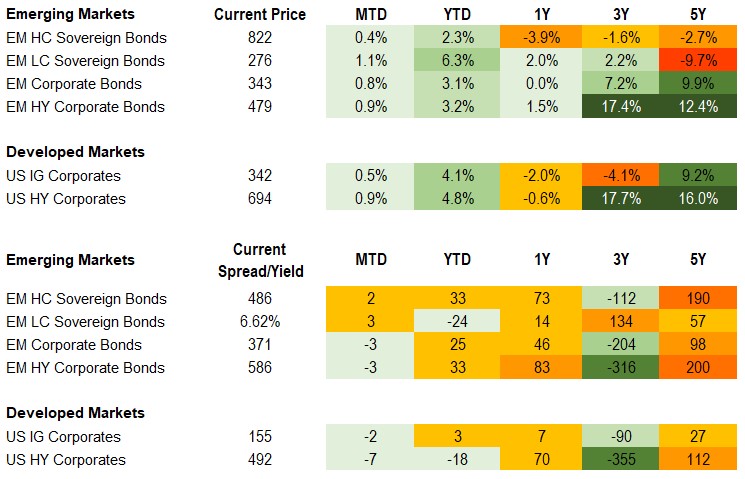
Equities
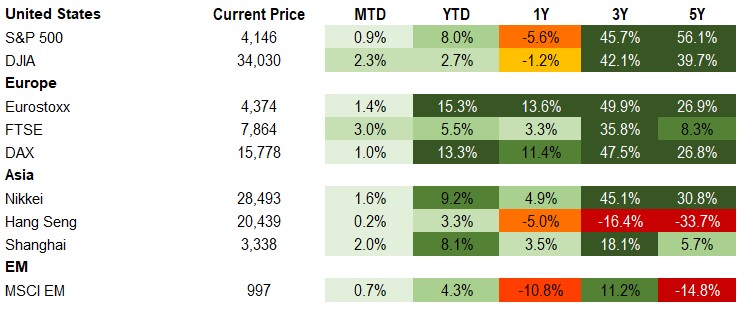
Commodities

Source for data tables: Bloomberg, JPMorgan, Gramercy. EM Fixed Income is represented by the following JPMorgan Indicies: EMBI Global, GBI-EM Global Diversified, CEMBI Broad Diversified and CEMBI Broad High Yield. DM Fixed Income is represented by the JPMorgan JULI Total Return Index and Domestic High Yield Index. Fixed Income, Equity and Commodity data is as of April 14, 2023 (mid-afternoon).
Emerging Markets Weekly Highlights
The IMF’s latest World Economic Outlook (WEO) highlights a rocky recovery
Event: The Fund downgraded its 2023 global growth forecast to 2.8%. This marks a partial unwind in the IMF’s recent upgrade to 2.9% in January, when it had lifted its view of global growth from 2.7% in its October update.
Gramercy commentary: There were several striking features within the IMF’s publication. First, the Fund sees a 25% chance that growth could fall below 2.0% in 2023. Going back to the early 1970s, there have only been five occasions when this has occurred, in 1973, 1981, 1982, 2009, and 2020. One of the largest risks is a synchronized policy tightening cycle in developed markets. The Fund explicitly referenced “unknown unknowns” in relation to the higher cost of capital. Second, there is an expectation that the global baseline forecast for inflation will decline from 8.7% in 2022 to 7.0% in 2023. Third, the pace of disinflation should accelerate globally, where 76% of economies are expected to experience lower headline inflation in 2023. Finally, the Fund highlighted that U.S. growth has been upgraded, but stagflation remains a risk with GDP growth of just 1.6% and 1.1% in 2023 and 2024, respectively. The EM-DM growth differential narrowed to 1.3% in 2022, however this is expected to improve to 2.6% in 2023, which is a downgrade from the January update, but flat to the October publication. The IMF did accredit successful EM management of the inflationary backdrop. The very economies that adopted conservative monetary and fiscal policies are expected to fare better. This includes rate hikes, limited FX intervention with the aim of preserving FX reserves, and targeted social fiscal measures. On this point in particular, the Fund upgraded Mexico’s 2023 growth up to 1.8% from 1.7%.
Brazil’s headline fell back to within the Central Bank of Brazil’s (BCB) target range
Event: Brazilian Institute of Geography and Statistics inflation decelerated to 4.65% in March, down from 5.60% in February and reflected its lowest level in twelve months.
Gramercy commentary: Brazil’s inflation had been running hot and well above the BCB’s target for over two years. Monthly CPI rose by 0.71%, which brought the year-over-year inflation to 4.65% and within the BCB’s targeted band of 3.25% +/- 1.5ppts. Core inflation also decelerated for a ninth month to 7.78%, but the monthly reading almost halved to 0.37% from the prior month. The BCB’s precondition for a rate cut had been a level consistent with consolidated disinflation, which has now been met although the policy rate has remained at 13.75% since August. The window for policy rate cuts is relatively narrow as inflation is likely to pick up once again in 3Q as base effects roll-off, given the impact of tax cuts from last year. Nevertheless, the ex-ante real rate rose above 8% and is double the BCB’s real neutral rate of 4%. A further complication that will test the pace of easing, is the government’s ability to maintain fiscal discipline.
Global Banking Sector Volatility
Event: EM financials successfully reopened primary debt markets after the SVB/Credit Suisse shock.
Gramercy commentary: The generic global banking sector contagion fears have moderated considerably in the last few weeks following the SVB/Credit Suisse crisis. The focus now shifts to the upcoming Q1’23 earnings season where attention will be on deposit beta and updates in management guidance for 2023 given the higher probability of growth slowdown/recession. The secondary market has continued to see a gradual recovery in bank Tier 2 and AT1 product post the Credit Suisse AT1 write-down event, and a rapid return to orderly functioning of wholesale funding markets. Numerous successful primary market transactions have been priced in both secured and senior unsecured formats with bank activity from Brazil, Korea, India, Indonesia, and Saudi Arabia. Banco do Brasil followed the recent sovereign issue and successfully reopened the Brazilian financials USD primary market after a 15-month hiatus with a $750m 7yr sustainable bond pricing at 6.5% yield paying a c.20-25bps concession with a solid $2.2bn+ orderbook. We expect to see ongoing senior unsecured supply from most jurisdictions as banks take advantage of improved UST stability and prioritize funding while awaiting more attractive levels before considering capital issuance.
China Evergrande and Sunac China announced their offshore restructuring proposal
Event: China property developers, China Evergrande and Sunac China, released their offshore restructuring proposal recently. Both proposals offer several different options where creditors can choose to convert their debt holdings into new debt securities or to equitize debt wholly or partly. In the case of China Evergrande, the company has different options for different classes of creditors. Evergrande creditors can choose to equitize debt holdings into the various entities, including the electric vehicles, property management and development businesses, or convert holdings into new securities with a maturity of 10-12 months with an interest rate of 2-4% in cash/PIK or new notes with a maturity of 5-8 years with an interest rate of 5.0-7.5% in cash/PIK. The company expects to finalize the restructuring by October 2023. In the case of Sunac China, creditors can choose to equitize debt holdings into the property management or development businesses or to convert into new securities with a maturity of 2-9 years with interest rates ranging from 5.0-6.5% where the company can choose to pay some of the interest as PIK.
Gramercy commentary: We see the announcements as constructive as both companies have moved forward with offshore restructuring proposals, which have been highly anticipated for months. Both China Evergrande and Sunac China are large-scale top 5 private property developers in China and the offshore restructuring proposals are likely to set a benchmark for other property developers. Both proposals are also in line with what was leaked in the press earlier and show a willingness of the company to move forward. We believe there is a decent chance the proposals are accepted. Other near-term positive catalysts for the China property sector include a gradual improvement in home sales after summer 2023 and more in 2024E, a further improvement in the regulatory environment with further supportive measures for the property sector, further improvement of financing conditions, as well as full restructuring offers from other developers such as Logan and Shimao. We expect these developments and short-term catalysts will lift investor’s sentiment further as we continue to believe that current bond prices in the sector are attractive and don’t reflect potential recovery values.
Emerging Markets Technicals
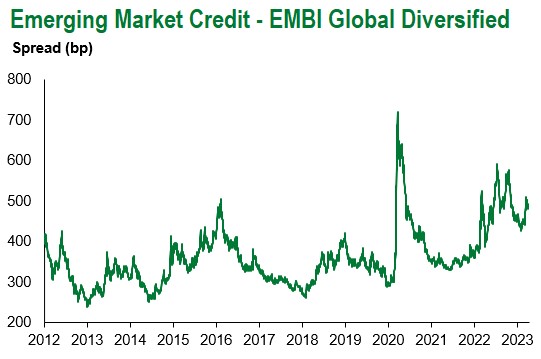
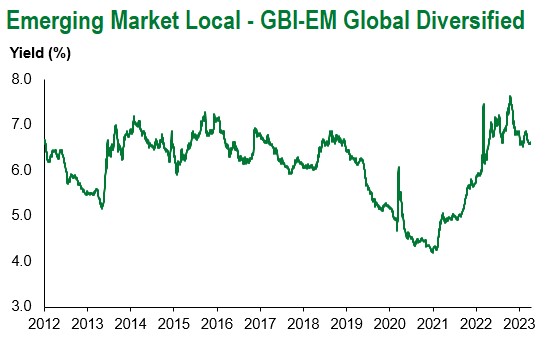
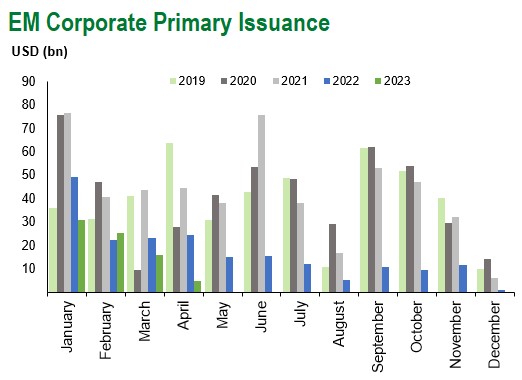
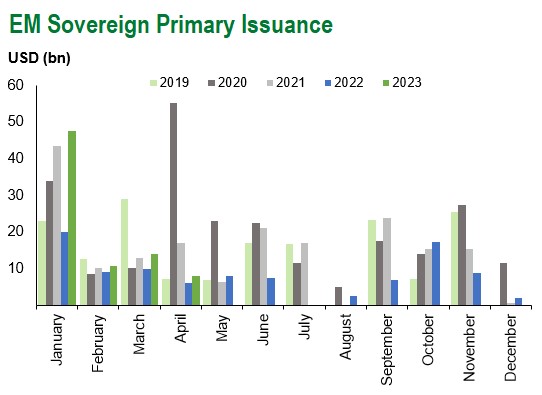
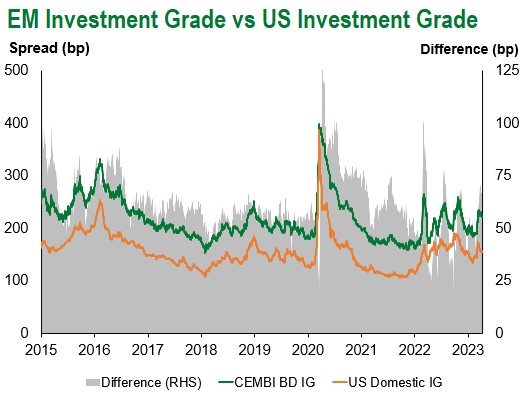
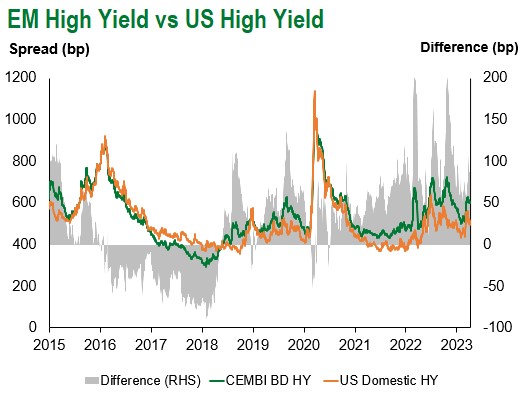
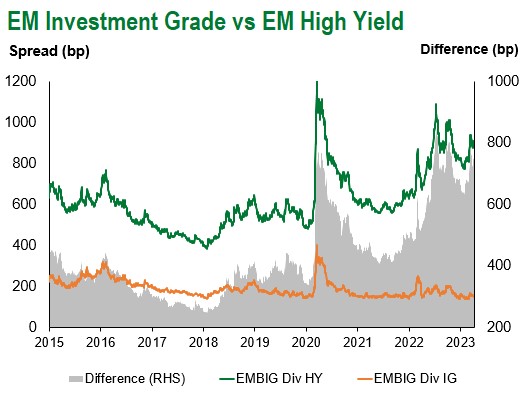
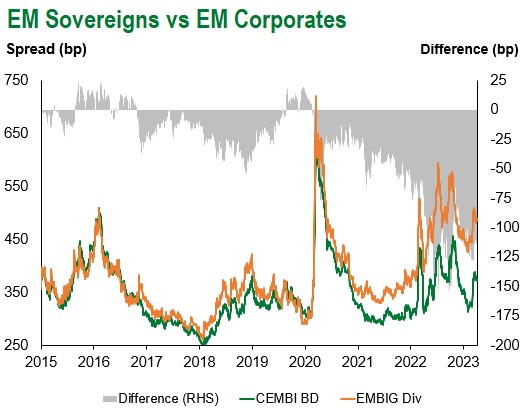
Emerging Markets Flows
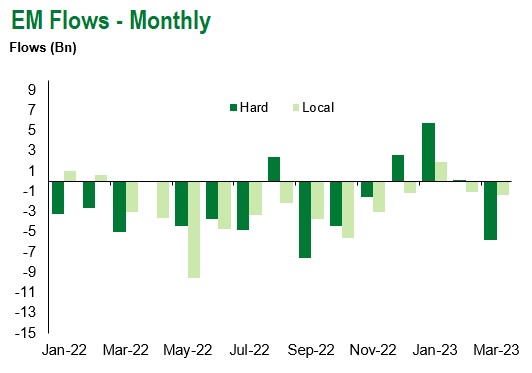
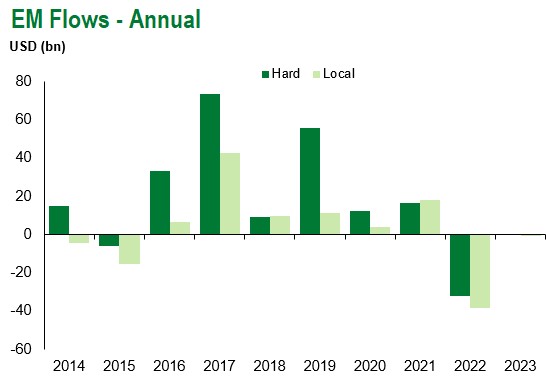
Source for graphs: Bloomberg, JPMorgan, Gramercy. As of April 14, 2023.
For questions, please contact:
Kathryn Exum, CFA ESG, Director, Co-Head of Sovereign Research, [email protected]
Petar Atanasov, Director, Co-Head of Sovereign Research, [email protected]
James Barry, Director, Deputy Portfolio Manager, [email protected]
This document is for informational purposes only. The information presented is not intended to be relied upon as a forecast, research or investment advice, and is not a recommendation, offer or solicitation to buy or sell any securities or to adopt any investment strategy. Gramercy may have current investment positions in the securities or sovereigns mentioned above. The information and opinions contained in this paper are as of the date of initial publication, derived from proprietary and nonproprietary sources deemed by Gramercy to be reliable, are not necessarily all-inclusive and are not guaranteed as to accuracy. This paper may contain “forward-looking” information that is not purely historical in nature. Such information may include, among other things, projections and forecasts. There is no guarantee that any forecasts made will come to pass. Reliance upon information in this paper is at the sole discretion of the reader. You should not rely on this presentation as the basis upon which to make an investment decision. Investment involves risk. There can be no assurance that investment objectives will be achieved. Investors must be prepared to bear the risk of a total loss of their investment. These risks are often heightened for investments in emerging/developing markets or smaller capital markets. International investing involves risks, including risks related to foreign currency, limited liquidity, less government regulation, and the possibility of substantial volatility due to adverse political, economic or other developments. References to any indices are for informational and general comparative purposes only. The performance data of various indices mentioned in this update are updated and released on a periodic basis before finalization. The performance data of various indices presented herein was current as of the date of the presentation. Please refer to data returns of the separate indices if you desire additional or updated information. Indices are unmanaged, and their performance results do not reflect the impact of fees, expenses, or taxes that may be incurred through an investment with Gramercy. Returns for indices assume dividend reinvestment. An investment cannot be made directly in an index. Accordingly, comparing results shown to those of such indices may be of limited use. The information provided herein is neither tax nor legal advice. Investors should speak to their tax professional for specific information regarding their tax situation.
